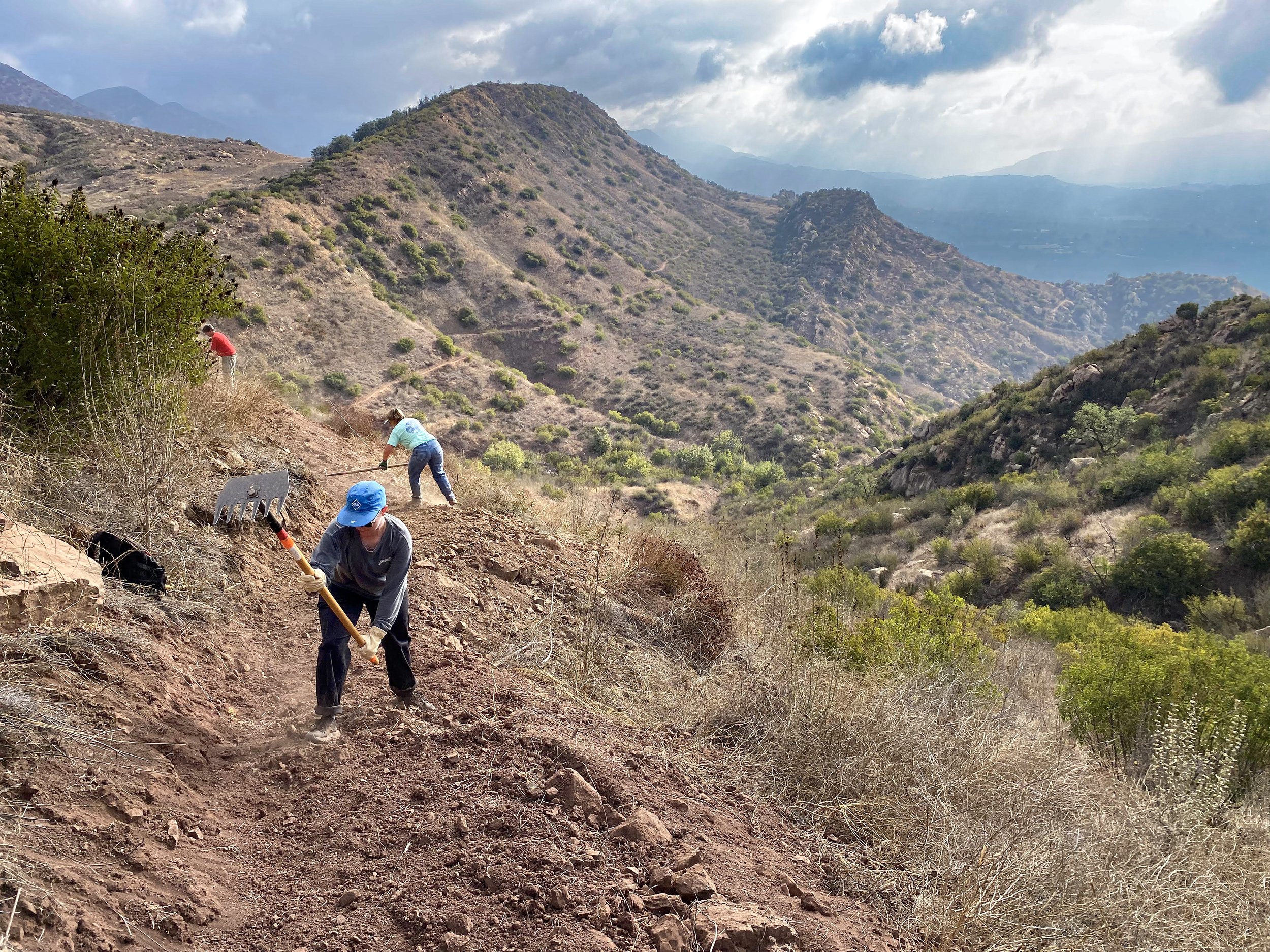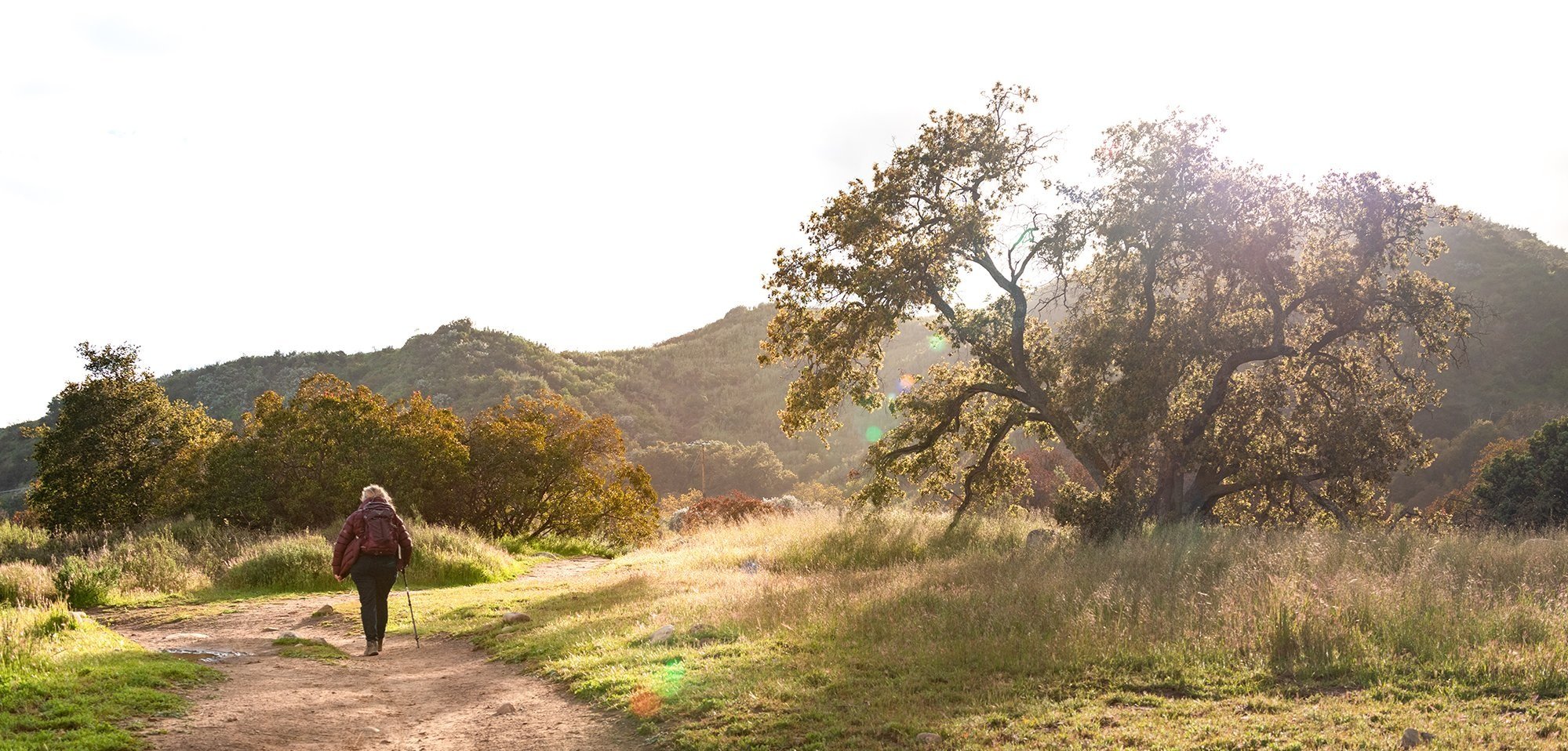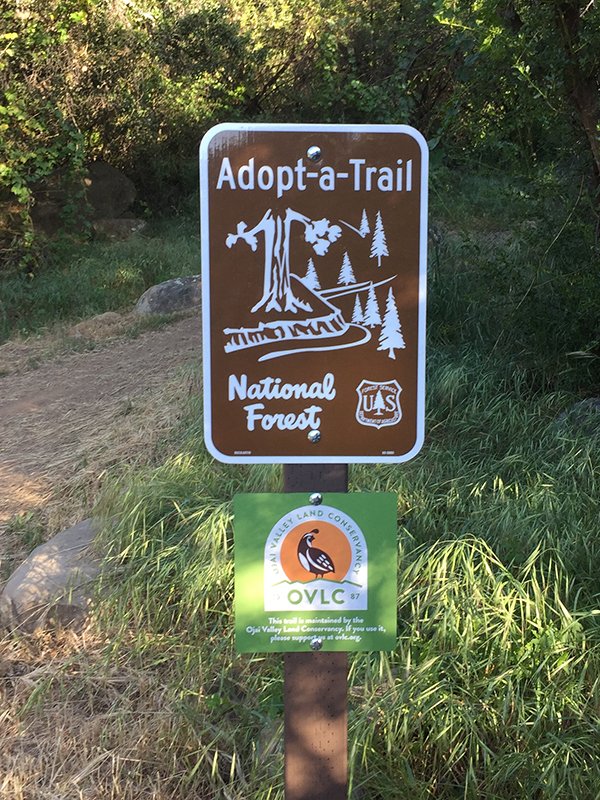
TRAIL MANAGEMENT

Due to a number of factors, many land trusts do not allow public access on their lands. One significant factor concerns the fact that recreational trails can impair habitat values since they are an area where nature is removed or disturbed through use.
However, the OVLC strives to connect people with the land in need of protection, as we believe that engagement in nature is an important component of building support for our mission. Supporters who understand the value of open spaces and habitat will often help us achieve our goal of protecting and restoring more land in the Ojai Valley. Trail management guides our efforts to maximize accessibility for all of our users, while also ensuring that we protect the natural resource values that OVLC has been entrusted to preserve.
The first consideration in trail management is determining and evaluating the density and location of trails. We want to maximize users' access and experiences on OVLC preserves, while also ensuring sufficient wild areas are set aside for wildlife habitat and to minimize damage to the Ojai Valley’s fragile arid ecosystems. This is important because trail impacts on habitat can go beyond their alignment, as some animals give a wide berth to trails.
We also limit our network of trails so that trail users can feel connected with the natural environment, and experience a landscape that is less fragmented by trail junctions. Occasionally trails are closed or moved to allow for an area to recover. While it is frustrating when your favorite trail or loop no longer exists, please understand that OVLC is going to the effort to stay true to our mission of conservation, and we often provide alternative routes. Lastly, many of our trails pass through private land (via trail easements) or near homes. We try to minimize the impact of our trails on our neighbors—and respect their wishes for privacy.
Volunteers clear trail at the Ventura River Preserve
Allan Jacobs Trail follows the natural contour of the a southwest facing drainage as it nears it's junction with Chaparral Crest (Photo taken April 17, 2020)
Once a trail location is determined, the design of the trail is then matched to the terrain. When new trails are designed, the goal is to try to follow the natural contours of the land, and thereby minimize the amount of structures (drainage, erosion control, and bridging) and design features that are needed to support the trail. Trails built this way are sustainable, both economically and environmentally. However, when this is not possible, or when we are maintaining existing trails, we use the following design features:
Switchbacks and climbing turns
Switchbacks and climbing turns are sustainable design features that are installed on steep terrains to make the climb easier, while also allowing for water runoff and minimizing erosion.
Out-sloped benching
Out-sloped benching is the subtle slanting of trails to match the slope of the hillside. This encourages water to flow in a natural course down the hillside, and not channelize along the trail.
Rolling drainage dips
Rolling draining dips are a maintenance feature that captures water that inadvertently starts to follow the trail and drains it off of the trail. All new trails are designed with this feature to prevent the need to build water bars, and older trails are occasionally retrofitted with this feature.
The trails we manage in the Ojai Valley are largely multi-use trails, open to equestrians, mountain bikers, and hikers (the trails on our Valley View and Ojai Meadows Preserves are closed to equestrians). When we consider the maintenance needs of an individual trail, or network of trails, we strive to balance varied trail uses with our mission of conservation.
While trails allow people to recreate freely and enjoy the surrounding natural landscape, they are often the cause of damage to the land. In addition to the land that is impacted to create a trail, trails can also lead to significant off-trail resource damage. In order to protect the surrounding land, we first assess trails for any spots that are causing off-trail impacts to habitat. Trail users will often veer around protruding rocks, or climb up the bank of a trail to avoid a muddy spot. Our first focus of work is to prevent this type of trail creep.
It’s understandable that people go around obstacles, especially if those obstacles are unsafe. When it comes to safety, we have no choice but to consider the most impactful user of a trail—in most cases, equestrians. Horses are the largest, heaviest, and least nimble of trail users. While a hiker and even a biker in many cases, can scale rocks or tip-toe around a blown-out section of tread, equestrians often cannot. Therefore, OVLC designs trails to be wide enough and stable enough for equestrians.
Once we have maximized the safety and minimized the impact of our trails OVLC then looks to improve the enjoyment factor of a trail and thereby the appreciation of the preserve. For example, OVLC worked closely with mountain bikers when we built the new Allan Jacobs Trail, to make sure that turns on the trail “flowed” and were fun to ride.
But it is impossible to make every mile of trail enjoyable to every user equally. Even within the three user groups of our trails, there is a wide variety of users—some mountain bikers prefer an easy dirt path like the Orange Grove Trail, while others want a technical single track and a strenuous climb. Some hikers want an epic adventure, others just a pleasant nature walk. Since all OVLC trails are essentially front country, accessible right from the road, our trails are designed to be inclusive of all interests.
The OVLC manages 27-miles of trails in the Ojai Valley, but in reality, we are part of the larger trail system within the valley. We work in close partnership with the Los Padres National Forest (LPNF) so that together we can provide a variety of enjoyable experiences for all users in the Ojai Valley. Pratt and Gridley are Forest Service trails adopted and maintained by OVLC to Forest Service standards.
Trail management is not only the responsibility of land managers like the OVLC and LPNF. All trail users play an important shared role in managing and maintaining our collective trail system.
Stay on the tread—because you may be trampling sensitive vegetation and stressing fragile arid ecosystems.
Don’t cut switchbacks as they easily erode and damage surrounding vegetation
Practice common trail etiquette; yield to horses if you are on a bike or a hiker, and yield to hikers if on a bike.
By staying on trail and using trail etiquette, we’ll protect not only the surrounding habitat, but in some cases, we protect neighbor relations. In a place like the Ojai Valley, where many trails wind through private property, it is imperative that we all respect the privacy of neighboring landowners in an effort to prevent any access disputes.
Most importantly, OVLC trails are here because people work hard to keep them open, safe, and enjoyable. We hope you’ll come out and volunteer with us, as we continue to protect the land that has been entrusted to our care.

what we do
Our mission is to protect and restore the natural landscapes of the Ojai Valley forever.




